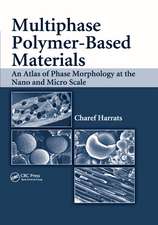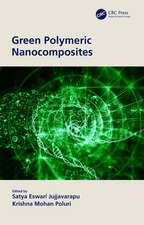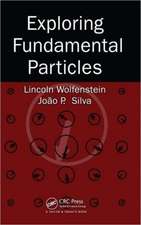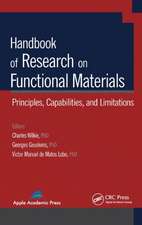Ion Beam Analysis: Fundamentals and Applications
Autor Michael Nastasi, James W. Mayer, Yongqiang Wangen Limba Engleză Paperback – 25 noi 2019
The book explains how ions interact with solids and describes what information can be gained. It starts by covering the fundamentals of ion beam analysis, including kinematics, ion stopping, Rutherford backscattering, channeling, elastic recoil detection, particle induced x-ray emission, and nuclear reaction analysis. The second part turns to applications, looking at the broad range of potential uses in thin film reactions, ion implantation, nuclear energy, biology, and art/archaeology.
- Examines classical collision theory
- Details the fundamentals of five specific ion beam analysis techniques
- Illustrates specific applications, including biomedicine and thin film analysis
- Provides examples of ion beam analysis in traditional and emerging research fields
Supplying readers with the means to understand the benefits and limitations of IBA, the book offers practical information that users can immediately apply to their own work. It covers the broad range of current and emerging applications in materials science, physics, art, archaeology, and biology. It also includes a chapter on computer applications of IBA.
| Toate formatele și edițiile | Preț | Express |
|---|---|---|
| Paperback (1) | 496.29 lei 6-8 săpt. | |
| CRC Press – 25 noi 2019 | 496.29 lei 6-8 săpt. | |
| Hardback (1) | 1269.38 lei 6-8 săpt. | |
| CRC Press – 27 aug 2014 | 1269.38 lei 6-8 săpt. |
Preț: 496.29 lei
Preț vechi: 583.87 lei
-15% Nou
Puncte Express: 744
Preț estimativ în valută:
94.97€ • 99.40$ • 79.04£
94.97€ • 99.40$ • 79.04£
Carte tipărită la comandă
Livrare economică 31 martie-14 aprilie
Preluare comenzi: 021 569.72.76
Specificații
ISBN-13: 9780367445843
ISBN-10: 0367445840
Pagini: 472
Dimensiuni: 156 x 234 x 25 mm
Greutate: 0.65 kg
Ediția:1
Editura: CRC Press
Colecția CRC Press
ISBN-10: 0367445840
Pagini: 472
Dimensiuni: 156 x 234 x 25 mm
Greutate: 0.65 kg
Ediția:1
Editura: CRC Press
Colecția CRC Press
Public țintă
Academic and Professional Practice & DevelopmentCuprins
Section I—Fundamentals. Overview. Kinematics. Cross Section. Ion Stopping. Backscattering Spectrometry. Elastic Recoil Detection Analysis. Nuclear Reaction Analysis. Particle-Induced X-Ray Emission Analysis. Ion Channeling. Section II—Applications. Thin Film Depth Profiling. Defects Measurements of a Crystalline Solid. Nuclear Energy Research Applications. Art and Archaeology Applications. Biomedical Applications. IBA Software. Appendices.
Notă biografică
Michael Nastasi is director of the Nebraska Center for Energy Sciences Research (NCESR) and Elmer Koch Professor in the Department of Mechanical and Materials Engineering at the University of Nebraska-Lincoln. Prior to this appointment he was director of the Department of Energy (DOE) Energy Frontier Research Center on Materials at Irradiation and Mechanical Extremes and nanoelectronics and mechanics thrust leader at the Center for Integrated Nanotechnologies (CINT). He served as team leader for the Nanoscience and Ion–Solid Interaction Team and as fellow at Los Alamos National Laboratory. He earned his PhD in materials science and engineering at Cornell University. Dr. Nastasi is an elected fellow of the American Physical Society (APS) and the Materials Research Society (MRS).
James W. Mayer (1930–2013), was a pioneer in the application of ion beam techniques for materials analysis. He received his PhD from Purdue University, followed by appointments at California Institute of Technology (1967–1980) and Cornell University (1980-1992), as Francis Norwood Bard Professor of Materials Science and Engineering and director of the Microscience and Technology Program. He was appointed to the faculty at Arizona State University (ASU) in 1992, where he became Regents’ Professor and P.V. Galvin Professor of Science and Engineering, as well as director of the Center for Solid State Science until his retirement. His research contributions were in many areas of solid-state engineering, especially ion implantation and Rutherford backscattering spectrometry. Among his many accolades, Dr. Mayer was recipient of the Materials Research Society’s Von Hippel Award, a fellow of the American Physical Society and Institute of Electrical and Electronic Engineers, and an elected member of the National Academy of Engineering.
Yongqiang Wang is the team leader of the Ion Beam Materials Laboratory (IBML) in Los Alamos National Laboratory. Dr. Wan
James W. Mayer (1930–2013), was a pioneer in the application of ion beam techniques for materials analysis. He received his PhD from Purdue University, followed by appointments at California Institute of Technology (1967–1980) and Cornell University (1980-1992), as Francis Norwood Bard Professor of Materials Science and Engineering and director of the Microscience and Technology Program. He was appointed to the faculty at Arizona State University (ASU) in 1992, where he became Regents’ Professor and P.V. Galvin Professor of Science and Engineering, as well as director of the Center for Solid State Science until his retirement. His research contributions were in many areas of solid-state engineering, especially ion implantation and Rutherford backscattering spectrometry. Among his many accolades, Dr. Mayer was recipient of the Materials Research Society’s Von Hippel Award, a fellow of the American Physical Society and Institute of Electrical and Electronic Engineers, and an elected member of the National Academy of Engineering.
Yongqiang Wang is the team leader of the Ion Beam Materials Laboratory (IBML) in Los Alamos National Laboratory. Dr. Wan
Descriere
This book explains the basic characteristics of ion beams as applied to the analysis of materials, as well as IBA of art/archaeological objects. It focuses on the fundamentals and applications of ion beam methods of materials characterization. It starts with coverage of the fundamentals of ion beam analysis, including kinematics, ion stopping, R




















